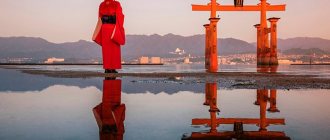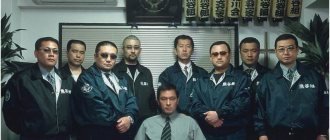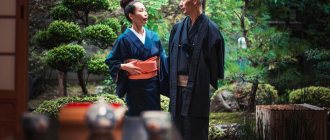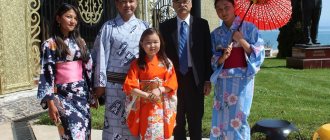Most Japanese people practice Buddhism along with Shintoism. Buddhism in Japan emerged from India, its founder Prince Siddhartha (on reaching adulthood - Gautama), disillusioned with the Hindu interpretation of the source of human suffering, rejected asceticism as a method of spiritual improvement and turned to meditation. After six years of wandering, he achieved a state of enlightenment (nirvana) while sitting under the Bodhi (knowledge) tree. Gautama, who became Buddha (enlightened), devoted the rest of his life to the teaching that “righteous thoughts” and “righteous deeds” should lead to the renunciation of all material and mental desires in order to escape from reality and achieve the “highest enlightenment” - nirvana.
Mahayana (Great Vehicle) is a broad path of salvation, one of the main directions of Buddhism, according to which not only a monk, but anyone who follows certain commandments and regulations can achieve nirvana. The Mahayana teachings came to Japan from China in the middle of the 6th century. Like many other things, the Japanese perfectly adapted this borrowing to their cultural values; The Buddha is regarded by them as an all-powerful kami, and over time, inconvenient aspects of the teaching, such as celibacy, disappeared and the focus became mainly on personal meditation.
Buddhism brought the diversity of Chinese culture to Japan. For two centuries, monks, artists and scholars went to China to study religion, art, music, literature and political science, which had a tremendous impact on the development of Japanese culture. Buddhism became involved in the political confrontations of the Nara and Heian periods - weak emperors used Buddhist and Chinese culture to strengthen their own power and add sophistication to their courts, as well as to weaken adherents of Shintoism.
At the same time, Buddhism did not conflict with Shintoism - temples and shrines were often located nearby, some kami became guardians and patrons of Buddhist temples, and various figures and symbols on Shinto altars helped the kami rise to the level of Buddha, considered as the highest spiritual being. Until the end of the 12th century, Japanese Buddhism remained the religion of the highest aristocracy . Around this time, the dominant Tendai sect split into new sects: Jodo, Jodo Shinei, Nichiren and Zen Buddhism. Each of them appealed to certain social groups. The first two gained particular popularity among the common population with very simple forms of rituals. The Nichiren sect required a more serious approach, while the meditation practice of the Zen sect, aimed at internal improvement, was more suitable for the samurai class and had a huge influence on Japanese traditional arts, including martial arts. Almost all modern Japanese Buddhists come from these sects, which continue to be influential today.
However, from the 15th century, Shintoism began to regain its lost positions. Various Shinto schools restore the priority of Komi over Buddha, trying to prove that Komi is just a Japanese version of Buddha. This process reached its climax after the Meiji Restoration of 1868, when Shinto officially became the state religion. Most Buddhist objects were removed from Shinto shrines and destroyed, and Buddhism fell into disgrace until the end of World War II, when religious freedom returned to Japan. Today, Buddhism and Shinto once again coexist peacefully and are followed by the vast majority of the Japanese population.
Religious origins
Archaeologists have long established that the first civilizations in Japan appeared much later than in other countries. Somewhere around the turn of our era. The legendary founder of the Japanese state was Emperor Jimmu. As legends say, he was a descendant of the sun goddess Amaterasu and lived around the third century AD; all Japanese emperors trace their history back to him.
The foundations of Japanese culture were laid by a complex process of cultural synthesis between local tribes and those that came. This also affected religion. Shinto, or “the way of spirits,” also known as Shintoism, is a belief about the world of gods and spirits that the Japanese have always revered.
The origins of Shintoism go back to ancient times, including the most primitive forms of beliefs, such as totemism, animism, magic, cults of leaders, the dead and others.
The Japanese, like most other peoples, spiritualized weather phenomena, animals, plants, and ancestors. They respected the intermediaries who communicated with the spirit world. Later, when Buddhism took root in Japan, Shinto shamans adopted many directions from the new religion, turning into priests who performed rituals to honor spirits and deities.
Vajrayana
Tibeto-Mongolian Buddhism
—Nyingma-pa
—International Dzogchen Community established by Namkhai Norbu Rinpoche (Santi Maha Sangha)
—Balaghat movement → neo-Buddhism by B. D. Dandaron
Six Mother Monasteries—Dorje Drag—Mindrolling—Palri—Kathog—Pelul—Dzogchen—Shechen
Famous terma cycles - Longchen Nyingthig - Chokling Tersar - Namchoi - Dudjom Tersar - Jangter (German) - Khordong Ter
Sarma-pa
—Sakya-pa
—Ancient Kadam-pa → Gelug-pa (New Kadam-pa)
—Kagyu(d)-pa
"Four Great Columns" (Ka-chen bzhi): line of Og Choikyi-Dorje (rNgog Chos-kyi-rdo-rJe) line of Tshur ('Tshur dBang-gi-rdo-rje) line of presentation according to the Matsongpa system (Mes-tshon- po dPyal-se-tsa) lineage of Milarepa's disciples
—Ka-Nying (Kagyu + Nyingma)
—Bon
—Ripa Ascetic yogic tradition in the Kagyu and Nyingma.
—Jonang-pa The school is sometimes considered a sub-school of Sakya, but Jonang developed as an independent school and its representatives themselves do not consider themselves part of Sakya.
—Dugal Shijed and Chod Does not exist as a separate lineage, but the teachings are practiced in all schools
It is generally said that there are four spiritual traditions in Tibet: Nyingma, Kagyu, Sakya and Gelug, with Gelug being the heir to the earlier Kadam tradition, resulting from the latter's reformation. However, when in December 1988 His Holiness the Dalai Lama convened a conference of tulkus (incarnate lamas) of different traditions in the Indian city of Sarnath, he emphasized that it was important to include the pre-Buddhist Bon tradition among the Tibetan traditions, thus speaking of the five Tibetan traditions .
The first tradition to appear in Tibet was the Nyingma tradition, which means “ancient” or “Old”. It was the result of the work of Guru Padmasambhava, who brought Buddhism to Tibet, King Trisong Detsen and Bodhisattva Shantarakshita.
The remaining schools belong to the "new translation" period, which began in the 10th century, when Rinchen Zangpo (958-1051) and other scholars formulated new canons of translation techniques that emphasized etymological accuracy rather than the freedom of style characteristic of the "old translations". The Sakya and Kagyu traditions are based on new tantra cycles that appeared at this time.
The Gelug tradition was founded by the scholar Tsongkhapa Lobzang Dragpa. It is the youngest of the four main schools of Tibetan Buddhism. The main role here is played by adherence to the monastic rules of the Vinaya and the “gradual path” to Enlightenment, inherited from Atisha. This lineage is now led by the Dalai Lama, a consciously reborn lama.
Pre-Buddhist Shintoism
Today, Shintoism and Buddhism exist peacefully in Japan, qualitatively complementing each other. But why did this happen? The answer can be obtained by studying the features of early, pre-Buddhist Shintoism. Initially, in the Shinto religion, a prominent role was played by the cult of dead ancestors, who symbolized the unity and cohesion of members of the same clan. The deities of earth, water, forests, mountains, fields and rain were also revered.
Like many ancient peoples, Japanese farmers solemnly celebrated the autumn and spring holidays, the harvest and the awakening of nature, respectively. If someone died, then that person was treated as if he had gone to another world.
Ancient Shinto myths still preserve the original Japanese version of ideas about the formation of the world. According to legends, initially there were only two deities in the world, Izanagi and Izanami - god and goddess. Izanami died trying to give birth to her first child, and then Izanagi went after her to the world of the dead, but was never able to bring her back. He returned to earth, and from his left eye the goddess Amaterasu was born, from whom the emperors of Japan descended.
Today the pantheon of Shinto gods is huge. At one time, this issue was not controlled or limited. But as far as intellectual attitude is concerned, this religion was not enough for a developing society. It was this reason that became fertile ground for the development of Buddhism in Japan.
Transformations
As we can see, Buddhism occupied a leading position in society both among high-ranking officials and among the common people.
Despite numerous clashes within various Buddhist associations and organizations, the positions of the teaching itself were not questioned until the end of the 16th century. Although already at that time Shintoism and Confucianism received preferences.
Shinto shrine
In 1868, when the shogunate was overthrown, Shinto became the official religion of Japan. Buddhist monasteries and temples began to close. In the 19th century, Shintoism and Buddhism separated.
However, despite the changes that occurred, in general the teachings of the Buddha did not completely lose their position and the majority of the Japanese adhered to this religion. This situation has not changed to this day.
New weapon in political struggle
The history of Buddhism in Japan dates back to the middle of the 6th century. During those times, the teachings of the Buddha played an important role in the political struggle for power. A few decades later, those who bet on Buddhism won this fight. Buddhism in ancient Japan spread as one of the two leading directions - Mahayana. It was these teachings that became key during the period of formation and strengthening of culture and statehood.
The new belief brought with it the traditions of Chinese civilization. It was this teaching that became the impetus for the emergence of administrative-bureaucratic hierarchy, ethical and legal systems. Against the background of these innovations, it was clear that Buddhism in Japan and China was noticeably different. For example, in the Land of the Rising Sun, attention was not focused on the fact that ancient wisdom has unconditional authority; moreover, unlike China, the opinion of an individual before the collective had a price. The “Law of 17 Articles”, which came into force in 604, mentioned that every person has the right to his own opinion, belief and idea of \u200b\u200bwhat is right. However, it was worth taking into account the opinion of the public and not imposing your principles on others.
Zen and its influence
In the 12th century, the teaching of Zen appeared in the country, which not only influenced the creation of the Rinzai-shu school, but also had a huge impact on the entire Japanese culture: literature, painting, architecture. Even in the tea ceremony, the influence of Zen culture is obvious.
Rinzai-shu was founded by the monk Eisai and received great acceptance from the imperial authorities and samurai. We can say that this philosophy was officially recognized by the state. The monasteries of this movement were united in the gozan system.
Naturally, this entire association was strictly controlled by the authorities. The school's dogmas emphasized the practice of meditation and the mastery of martial arts.
Another school of Zen Buddhism that became widespread was Soto-shu. Its ideologist was the Japanese philosopher Dogen. Sotho concepts were reminiscent of Tibetan Buddhism. This movement, unlike the previous one, carried out its activities on the periphery and had an influence on ordinary people.
Dogen
Spread of Buddhism
Despite the fact that Buddhism absorbed many Chinese and Indian movements, only in Japan the norms of this religion turned out to be the most durable. Buddhism in Japan played an important role in the development of culture, and starting from the 8th century it began to influence political life. The latter was facilitated by the Inke Institute. According to these teachings, the emperor was supposed to renounce the throne during his lifetime in favor of a future heir, and then rule the state as a regent.
It is worth noting that the spread of Buddhism in Japan occurred very quickly. In particular, Buddhist temples grew like mushrooms after rain. Already in 623, there were 46 of them in the country, and at the end of the 7th century a decree was issued on the establishment of Buddhist altars and images in official institutions.
Around the middle of the 8th century, the government of the country decided to build a large Buddhist temple in Nara Prefecture. The central place in this structure was occupied by a 16-meter statue of Buddha. To cover it with gold, the precious material was collected throughout the country.
Over time, the number of Buddhist temples began to number in the thousands, and sect schools, such as Zen Buddhism, began to actively develop in the country. In Japan, Buddhism found favorable conditions for its mass spread, but it not only did not suppress primitive local beliefs, but integrated with them.
How the teaching appeared in the Land of the Rising Sun
In the 5th century, the state of Yamato began to form on the Japanese islands. During this period, the Japanese introduced the best cultural achievements of their neighbors. They are borrowed from the countries of the Korean Peninsula:
- Baekje,
- Goguryeo,
- Silla
- and China.
The ruling elite of Yamato strives to create an ideal state, modeled on the mainland powers, and Buddhist teachings are borrowed from there at first more as part of the culture than faith. It helps rulers unite all citizens under common ideological banners.
Buddhism spreads both “from above”, at the direction of those in power, in order to influence the minds of their subjects, and “from below”: thanks to the Chinese and Korean communities that settled in Yamato or the territories nearby. From them, the ancient Japanese copied the style of mainland culture, adopted basic crafts and hieroglyphic writing.
Two religions
In the 8th century, the Kegon sect existed in the country, which had already taken shape and came into force. It was she who turned the capital's temple into a center that was supposed to unite all religious movements. But first of all it was necessary to bring Shintoism and Buddhism closer together. In Japan, they began to believe that the deities of the Shinto pantheon are Buddhas in their various rebirths. The Kegon sect managed to establish a “double path of spirits”, where two religions that had once supplanted each other were to merge into one.
The fusion of Buddhism and Shintoism in early medieval Japan was a success. The country's rulers turned to Shinto shrines and gods with a request to contribute to the construction of the Buddha statue. The Japanese emperors directly stated that they would support both Buddhism and Shintoism, without giving preference to any one religion.
Some of the most revered kami (deities) of the Shinto pantheon were awarded the status of Bodhisattva, that is, a heavenly Buddhist deity. Monks who professed Buddhism repeatedly took an active part in Shinto events, and Shinto priests visited temples from time to time.
Middle Ages
In the 9th century, two new schools were brought from China - Tendai-shu and Shingon-shu. These religious associations received official support from the imperial government.
The founder of the Tendai school was the monk Site. The stronghold of this movement was the Enryaku-ji Temple, located near Kyoto - one of the powerful monasteries, which is still the center of this school today.
Supporters of this movement did not accept any dissent regarding religious views, and even entered into open conflicts with those who held different points of view.
The Shingon sect was formed by the monk Kukai. This association emphasized the unity of Buddhism and the traditional Japanese religion of Shinto - numerous Shinto deities were perceived as incarnations of various Buddhas.
This school differed from the previous one in its peaceful attitude and lack of rigidity. It was also home to the cult of Buddha Vairocana.
Then, in the 11th century, the Pure Land School emerged. At that time, ideas about the imminent end of the world were quite common, and people desperately wanted to find some kind of salvation.
The essence of this doctrine was that there is a paradise where the Buddha Amitabha, or Amida (Japanese), lives, who will save everyone who asks him for it. Of course, such ideas became incredibly popular among the people and soon many Amidah communities and movements appeared.
Shingon
The Shingon sect made a significant contribution to the combination of Buddhism and Shintoism. In China, practically nothing is known about her, and her teachings came to India much later. The founder of the sect was the monk Kukai, who concentrated all his attention on the cult of Buddha Vairocana, who was perceived as a symbol of the cosmic Universe. Due to his involvement with the Universe, images of Buddha were different. This is what helped bring Buddhism and Shinto together - the Shingon sect declared the main gods of the Shinto pantheon to be avatars (faces) of Buddha. Amaterasu became the avatar of Buddha Vairocana. Mountain deities began to be seen as incarnations of Buddha, which was taken into account when building monasteries. In addition, the mystical rituals of Shingon made it possible to qualitatively compare the Shinto deities who personified nature with the cosmic forces of Buddhism.
Buddhism in Japan in the Middle Ages was already an established, full-fledged religion. He ceased to compete with Shintoism and, one might even say, divided ritual duties equally. Buddhist monks worked in many Shinto temples. And only two Shinto shrines - in Ise and Izumo - retained their independence. After some time, this idea was supported by the country’s rulers, who still saw Shintoism as a pillar of their influence. Although this is most likely due to the weakening of the role of the emperor and the beginning of the reign of the shoguns.
BUDDHISM IN JAPAN
Servants sweep away the dust of centuries. Big Buddha from Todaiji Monastery.
Science and life // Illustrations
Guardians of the gates of Todaiji Monastery.
‹
›
The teachings of the Buddha originated in Ancient India, it has come a long way, crossing the ridges of the Himalayas, the great plains of China, the mountains and valleys of Korea. It took Buddhism a whole millennium to come to the Japanese islands. On his long journey to them, he absorbed the beliefs of the peoples through whose lands he walked, included their gods and saints in his pantheon, and was enriched by the research of Indian and Chinese sages. All this boundless wealth of thought is reflected in hundreds and thousands of sutras, treatises, and commentaries. This is the treasury of faith and knowledge that the Japanese received.
It is believed that Buddhism came to Japan in the 6th century. In fact, he penetrated there much earlier; Japanese chronicles note that he appeared along with Chinese and Korean settlers back in the 4th and early 5th centuries. However, the new teaching did not enjoy success at that time, and the people remained with their former Shinto beliefs (the cult of nature deities and ancestors). But in the 6th century, the teachings of Buddha were established in Asuka, the capital of the state.
In Japan, in the second half of the 6th century, there was a struggle between two powerful clans - Soga and Minonobe. The Soga are devout adherents of Buddhism, and the Minonobe are protectors of their former gods. The reason for the struggle lay in the rivalry for power in the nascent state, and it ended in the victory of Sog. As we see, Buddhism at this stage of its history belonged more to politics than to religion. And it took time and devotees for this creed to take deep roots, adapt to local conditions and flourish for centuries.
The Japanese initially perceived the Buddha as a “kami” - a Shinto deity, but only a foreign one. According to those who worshiped him, it had unlimited power and, therefore, was suitable for the role of a universal patron and intercessor. However, a lot of time had to pass, a Buddhist temple organization had to emerge, a layer of learned monks had to form who would begin to systematically study the sutras (rules) brought from overseas and develop their own concepts of salvation on this basis. But the cultural level of the educated layer of Japanese society also had to rise for Buddhism to reveal itself in all its richness and diversity.
Buddhist preachers did not seek to overthrow the local gods, who were still considered the guardians of the area. And the construction of a Buddhist temple was never started until the permission of the local gods was received. Even such a zealous adherent of Buddhist teachings as Shotoku-Taishi said in 607: “Can anyone stop respecting and offering prayers to the heavenly and earthly gods? Therefore, let all my associates worship the gods of Heaven and Earth with all their hearts.”
Buddhist temples were built according to Chinese models, and utensils for worship were also brought from China, only over time they began to be made in Japan. Sacred images were needed - painting and sculpture appeared, and the art of artistic casting developed. The 7th-8th centuries in Japan were the heyday of art, which was in one way or another connected with Buddhism. And Buddhist prayers were widely reflected in the fiction of that time.
SHOTOKU TAISHI FOUNDER OF JAPANESE BUDDHISM
According to Japanese chronicles, in 552 (according to other sources, in 538) an embassy from the Korean state of Baekje arrived at the court of the Yamato kings. The ambassadors brought sutras, images of Buddhas and a message from the king of Baekje. This is how the Buddha's teachings came to the Japanese islands. Prince Umayado, better known under the posthumous name Shotoku-Taishi - Prince of the “Holy Virtues” (574-622), became its zealous admirer, patron and active distributor. It is no coincidence that he is considered the founder of Japanese Buddhism.
Little reliable information has been preserved about Shotoku-Taishi. He was the son of King Yemei, but after the death of his father he received not the throne, but the post of regent under his aunt, Queen Suiko. Shotoku remained in this role for 30 years, proving himself to be an outstanding statesman. In search of means of strengthening central power, he turned his attention to China. The prince saw them in the centralized bureaucratic system that had developed there and sought to transfer it to Japanese soil. The idea of a new state organization received its first expression in Japan in the form of the “Law of 17 Articles” (604), the authorship of which is attributed to Shotoku-Taishi. This law is permeated with Confucian and Buddhist ideas; its text includes terms from ancient Chinese philosophy and historical literature. The beautiful style of the ancient Chinese language, the author’s wide erudition for his time, and the strongly expressed idea of absolute monarchical power raise doubts about the authorship of Shotoku. But there is another point of view, which admits that the text written by Shotoku was lost, and the currently known text was written on the basis of surviving fragments and legends.
Here are some excerpts from it translated by the famous Soviet orientalist Academician N.I. Conrad.
“The most important thing in governing the people is social norms. If there are no such norms at the top, there is no order at the bottom. If there is no order below, crime inevitably arises.”
“Carefully consider merit and demerit. Rewards and punishments must be appropriate. But lately, rewards are not given according to merit, punishments are not given according to faults.”
“Don’t decide big things yourself! Be sure to consult with the people."
Whoever compiled this kind of declaration of principles of government was well acquainted with the main trends of Chinese social thought. The norms of Confucianism can be clearly seen in the advice not to distract people from doing other things when they are busy working in the fields, otherwise “what will we eat?”
The “Table of 12 Ranks” is also associated with the name Shotoku. It was introduced in 603 to streamline the bureaucracy. Persons who were awarded this or that title were required to wear a special headdress made of fabric of different colors. The titles themselves contained the meanings of Confucian virtues.
In 607, Shotoku-Taishi sent a message to the Chinese emperor, thereby opening the era of official relations with China. This is the first official appeal to the Chinese court, where the neighboring state called itself the Chinese word “Zhiben” - in Japanese it sounded like “Nippon” or “Nihon”, that is, the country of “Sunrise”. In 608, a group of young people was sent to China to receive education there, including scholar-monks. From then on, embassies were sent regularly until the end of the 9th century, joined by numerous groups of people seeking to study the sciences and arts.
Shotoku became a zealous admirer of Buddhism, not in words, but in deeds, and the initiator of an entire period in the history of the spiritual life of the Japanese. He wrote commentaries on three Buddhist sutras; through his efforts, the construction of Buddhist temples began; by the end of his life, 46 of them had been built. A silk curtain with an embroidered picture of the “Heavenly Kingdom” has survived to this day. Tradition claims that the embroidery is the work of the skillful hands of the prince's wife, and the words belong to him. These are the words: “Our world is a deception. Only Buddha is the truth."
In 607, Shotoku retired to the village of Ikaruga. Here his beloved concubine was born - a place dear to his heart. Rumor claimed that he took refuge there, tired of intrigue and deciding in silence to seriously study Buddhism. Having settled in the village of Ikaruga, the prince ordered the construction of a temple, which was destined to enter the treasury of world architecture. This is the famous Horyuji Monastery. In 670, a fire destroyed the building, but it was restored. The monastery burned more than once, but was reborn from the ashes. With each restoration, something changed in him. Experts believe that the main building - the golden temple, its five-tiered pagoda, central gate, gallery, wooden columns, and balustrade with a Buddhist swastika pattern preserve the style of the Asuka period - the time of life and work of Shotoku-Taishi.
***
Buddhism
- one of the three world religions. At its center is the teaching of the “four noble truths”: suffering, its cause, liberation and the path to it. In Buddhism there is no opposition between spirit and matter, there is no God as a creator and an unconditionally supreme being. Buddha is not only the name given to the founder of this religion, the legendary Prince Gautama (VII-VI centuries BC), but also the name of a being who has reached a state of highest perfection (“enlightenment”).
Sutra
- in ancient Indian literature this is the name given to short statements and sets of such statements. The sutras expounded various areas of knowledge and religious teachings.
Shintoism
- a religion common in Japan. It is based on the cult of nature deities and ancestors. The highest deity is Amaterasu.
Confucianism
- an ethical and political doctrine in China, the foundations of which were laid by Confucius (VI-V centuries BC). It declared the power of the ruler sacred, and the division of people into higher and lower (“noble men” and “little people”) as a universal law of justice.
See the issue on the same topic
E. ETINGOF - Living history.
Buddhism during the Shogunate
In the 9th century, the political power of the emperors was a mere formality; in fact, the entire reign began to be concentrated in the hands of shoguns - local military governors. Under their rule, the religion of Buddhism in Japan gained even greater influence. Buddhism becomes the state religion.
The fact is that Buddhist monasteries became the centers of administrative rule, and the clergy held enormous power in their hands. Therefore, there was a fierce struggle for positions at the monastery. This led to the active growth of the position of Buddhist monasteries in the political and economic arena.
For many centuries, while the period of the shogunate lasted, Buddhism remained the main center of power. During this time, power changed significantly, and Buddhism transformed along with it. Old sects were replaced by new ones that still influence Japanese culture today.
Development of Buddhism
Shingon and Tendai (from the 9th century)
In the 9th century, two new schools acquired the greatest influence: Tendai-shu (Template:Lang-ja) and Shingon-shu (Template:Lang-ja), the teachings of which were brought from China by Saicho (767-822) and Kukai (774-835) respectively. ). These schools attracted numerous adherents, but not so much for their complex philosophies as for their colorful and solemn rituals, intended to achieve all kinds of worldly benefits. The Tendai-shu and Shingon-shu schools enjoyed unquestioned authority at the imperial court.
The stronghold of Tendai, the Enryaku-ji monastery on Mount Hiei near Kyoto, which included more than 3,000 buildings, eventually turned into a powerful fortress. Ignoring the Buddhist commandments, Tendai monks fought with weapons in their hands against ideological opponents, mainly within their own school, often burned monasteries, besieged Kyoto and Nara, demanding support for the monasteries, and terrified the capital's population, and also interfered in the political life of the country.
The center of Shingon-shu is located on Mount Koya-san in the province of Kii (modern Wakayama), was no less impressive, but adherents of this school preferred not to resort to military force.
Pure Land Schools (from the 11th century)
From the middle of the 11th century, ideas about the advent of the era of the “end of the Law” (mappo) became widespread in Japan, which was a powerful stimulus for the search for new and more effective means that would allow achieving quick and guaranteed salvation. The doctrine of the Western Paradise or “Pure Land” (Jodo), which came from China, where the Buddha Amitabha (Japanese Amida) resides, who made the “primordial vow” (hongan) to save anyone who turns to him with a sincere call for help, formed the basis several Amidist schools (see Amidism). Renin (1073-1132) founded the Yuzu-nembutsu school (Template:Lang-ja), Honen (1133-1212) founded the Jodo-shu school, his student Shinran (1173-1263) founded the Jodo-shinshu, and Ippen (1239-1289) ) - Ji-shu school ((Template:Lang-ja)). These schools differed in their interpretation of the specific methods leading to salvation, but they all recognized the superiority of salvation with the help of someone else's power over salvation through "one's own strength", and considered the most effective practice to be nenbutsu - the continuous utterance of the formula "Namu Amida Butsu!" (“Glory to Amida Buddha!”).
Zen (from the 12th century)
Rock Garden
At the end of the 12th century, the teachings of the Zen school came from China to Japan. The founder of the Rinzai-shu movement was Eisai (1149-1215). Very soon, Rinzai-shu gained strong sympathy in Japan, primarily among the samurai and the imperial entourage, effectively turning into an officially patronized ideology. Almost all monasteries of this direction were part of the hierarchical gozan
(literally “five mountains”), which was under direct government control.
Gozan monasteries became major centers of culture, and the monks who lived in them were not only guardians of knowledge, but also creators of literature in Chinese, called gozan bungaku
(“literature of the five monasteries”). Until the beginning of the 16th century, the intellectual hegemony of the Gozan monks was almost complete.
The founder of another Zen movement, Soto-shu, was Dogen (1200-1253), one of the most profound and original Japanese thinkers. He preferred to avoid government officials, so Soto's ideas spread mainly in the provinces, where they met with support from local feudal lords. The reformer of Soto was Keizan Sokin (1268-1325), under whom Soto's followers adopted and began to practice many rituals of esoteric Buddhism and attempts were made to involve broad sections of the popular masses in this direction.
Nichiren (from the 13th century)
In the 13th century, the Nichiren-shu school arose, a school that arose directly in Japan without the help of Chinese or Korean preachers. Its founder, Nichiren (1222–1282), among all Buddhist works, especially singled out the Lotus Sutra (Saddharmapundarika Sutra; Japanese Hokkekyo), which was also especially valued by the Tendai school. Nichiren argued that only its study, and most importantly, a respectful attitude towards it, could ensure the prosperity of the country and the happiness of its admirers. For this, he recommended the practice of daimoku - the constant repetition of the mantra “Namu Myoho rengekyo!” (“Glory to the Lotus Sutra of the Good Law!”). Unlike the esoteric schools of Shingon and Tendai, which focused on the court aristocracy, or Rinzai-shu, which relied on samurai, the Nichiren-shu school, as well as the Amida schools, thanks to the simplicity of their teachings, attracted many commoners, which is why they became widespread in the provinces . It is no coincidence that it was the Amidite preachers who acted as instigators of religious peasant revolts (ikko-ikki), directed against oppression by feudal lords and officials.
Civil strife of the 13th-16th centuries and the weakening of the role of monasteries
Despite the ongoing civil strife, as a result of which monastic buildings often burned to the ground, during the 13th-15th centuries Buddhism strengthened its position, expanded its spheres of influence, and actively participated in politics. Only at the end of the 16th century, thanks to the activities of the country’s unifiers Oda Nobunaga (1534-1582) and Toyotomi Hideyoshi (1536-1598), the economic power of large monasteries was broken and they lost their former privileges.
The period of the Tokugawa shogunate of the 17th-19th centuries
Although the government of the Tokugawa Shogunate (1603-1868) gave preference to the moral and ethical teachings of Neo-Confucianism, the attitude towards Buddhism in general was quite favorable, and it was used as a convenient tool to eradicate Christianity, which had become widespread in Japan, and also helped the authorities to carry out secret surveillance of the population . Each family was assigned to a specific temple (regardless of personal sympathies for a particular school), in which they had to register. At the same time, in the depths of Buddhist schools there were active processes of understanding philosophical concepts and their subsequent transformation taking into account new conditions.
Such major preachers as Takuan Soho (1573-1645), Bankei Yetaku (1622-1693), Hakuip Ekatsu (1683-1768), Suzuki Shosan (1579-1655), Onko Jiun (1718-1804), began to abandon the Chinese language and use Japanese for sermons and in his writings. At the same time, tendencies towards syncretism intensified, which was manifested not only in the desire to borrow certain provisions from other Buddhist schools, but in an increasingly frequent appeal to Confucianism and Shintoism.
Ordering of religions during the Meiji period
After the overthrow of the shogunate (1868, see Meiji Restoration), Shintoism was declared the state ideology, which indicated the growth of nationalist sentiments in the country. Many Buddhist temples were closed, but this did not indicate the final loss of Buddhism. Currently, the vast majority of the Japanese population is officially considered followers of Buddhism, although the Japanese attitude towards religion manifests itself mainly at the external level, primarily as part of tradition. During this period, the state streamlined the system of cults and determined the status of schools, which basically remains the same to this day.
Dzedo
The first to appear was the Dzedo sect, where the cult of the Western Paradise was preached. This movement was founded by Honen, who believed that Buddhist teachings needed to be simplified, making them more accessible to ordinary Japanese. To achieve what he wanted, he simply borrowed from Chinese Amidism (another Buddhist movement) the practice of repeating words that were supposed to bring salvation to believers.
As a result, the simple phrase “Oh, Buddha Amitaba!” turned into a magic spell that could protect the believer from any misfortune if repeated constantly. This practice has spread like an epidemic throughout the country. It is easy for people to believe in the easiest way of salvation, such as rewriting sutras, donating to temples, and repeating a magic spell.
Over time, the turmoil around this cult subsided, and the Buddhist movement itself acquired a calmer form of manifestation. But the number of followers did not decrease from this. Even now there are 20 million representatives of Amidism in Japan.
Nichiren
The Nichiren sect was no less popular in Japan. It was named after its founder, who, like Honen, tried to simplify and purify Buddhist beliefs. The center of worship of the sect turned out to be the Great Buddha himself. There was no need to strive for the unknown Western paradise, because Buddha was around, in everything that surrounded man and in himself. Therefore, sooner or later, Buddha will definitely manifest himself even in the most offended and oppressed person.
This movement was intolerant of other sects of Buddhism, but its teachings were supported by many disadvantaged people. Of course, this circumstance did not give the sect a revolutionary character. Unlike neighboring China, in Japan Buddhism rarely became the banner of peasant uprisings. In addition, Nichiren proclaimed that religion should serve the state, and this idea was actively supported by nationalists.
Buddhist temples and ceremonies
Like Shinto shrines, Buddhist temples (names ending in -tera, -dera, or -ji) exhibit a rich variety of architectural styles, depending on the time of construction and the sect that owns the temple; but they always show a strong influence of the art of China and Korea. The main hall of the temple is called kon-do or hon-do; this is usually where the main Buddha sculpture and donation table are located. Sometimes the entrance gate (sanmon) is already part of the temple, representing a two-story building with a pair of brightly painted fierce guards - Nyo, or Kongo rikishi. Despite his menacing appearance, Nio is actually a good-natured creature, but not for evil spirits.
On the territory of some temples there are pagodas, usually three to five stories high, each floor has a separate roof, and the top of the pagoda is crowned with a metal spire. Historically, pagodas, which house the relics of Buddha, served as the center of Buddhist ceremonies. Depending on the size of the temple complexes, they may also house other buildings: a study hall (ko-do), a treasury or sutra repository, living quarters, and a temple store. Zen Buddhist temples, especially the picturesque structures in Kyoto, are also known for their beautiful rock gardens and landscaped parks created specifically for meditation.
Buddhism, unlike Shintoism, is not characterized by colorful holidays and rituals. Instead, a simple prayer, the unforgettable smell of smoking incense and donations: food, flowers or money. The picture of Zen Buddhism meditating in the lotus position leaves a strong impression; slow breathing, freeing the mind from everything unnecessary and from time to time blows with a bamboo stick (so as not to fall asleep), for which the poor fellows also thank their executor.
The most important Buddhist holiday is Obon (from late July to mid-August), when the spirits of departed ancestors return home to earth. Then come the spring and autumn equinoxes (o-higan), usually March 21 and September 23, another occasion to visit the graves of ancestors. Still, the biggest event is considered to be the New Year - Shogatsu, although this is more of a Shinto holiday than a Buddhist one. A few non-working days allow you to have a lot of fun, have a good drink and at the same time do not forget to visit a local temple or sanctuary and pray for good luck in the coming year.
See also articles How to travel to Japan on your own
Zen Buddhism
The most famous sect is Zen Buddhism, where the Japanese spirit was fully manifested in the context of Buddhism. The teaching of Zen appeared in Japan much later than Buddhism. The southern school received the greatest development. It was preached by Dogen and introduced some of his principles into this movement. For example, he respected the authority of the Buddha, and this innovation played a key role in the creation of the sect. The influence and possibilities of Zen Buddhism in Japan turned out to be very great. There were several reasons for this:
- The teaching recognized the authority of the teacher, and this contributed to the strengthening of some native Japanese traditions. For example, the Inca institution, according to which the author renounced his powers in favor of the future heir. This meant that the student had already reached the level of the teacher.
- Zen monastery schools were popular. They were raised harshly and cruelly here. A person was taught to persistently achieve his goals and be ready to sacrifice his life for this. This upbringing greatly appealed to the samurai, who were ready to die for the sake of the master and honored the cult of the sword above life.
Actually, this is why the development of Zen Buddhism was so actively patronized by the shoguns. This sect, with its principles and norms, basically determined the code of the samurai. The warrior's path was difficult and cruel. The warrior's honor was above all - courage, loyalty, dignity. If any of these components were desecrated, they had to be washed off with blood. A cult of suicide in the name of duty and honor developed. By the way, not only boys in schools, but also girls from samurai families were specially trained to do hara-kiri (only girls stabbed themselves with a dagger). They all believed that the name of the fallen warrior would go down in history forever, and therefore they were fanatically devoted to their patron. It was these components that had a significant influence on the national character of the Japanese.
Nichiren-shu
Nichiren, the founder of the school of the same name, spent 16 years of his life studying in various monasteries and in Tendai Enryakuji. From what he learned, he realized that the very essence of the Buddhist Dharma is contained in the Lotus Sutra.
From that moment on, he always and everywhere tried to convey this idea and publicly declared the fallacy of the teachings of other schools of his time. For this he was subjected to persecution, assassination attempts, attacks and exiles, and was once almost killed.
But he did not back down from his sermons. Having come into conflict with the authorities, he was sentenced and was about to be executed when a sign occurred in the form of light from the heavens and the surface of the sea. They were afraid to execute him, and the punishment was replaced with exile.
Nichiren (02/16/1222 - 10/13/1982) - Japanese monk, founder of the Nichiren-shu school
From that moment on, he began to be considered a bodhisattva, or even a buddha. After serving his exile, having written his main works in it, Nichiren lived on the mountain, his followers erected the Kuonji Temple there. He devoted the rest of his life to his students and the development of teaching.
Nichiren's legacy lies in the mantra that, by chanting (Shodai practice), one can achieve final enlightenment: Namu-Myo-Ho-Ren-Ge-Kyo. This mantra - Daimoku - glorifies the Lotus Sutra and expresses devotion to it.
Death and modernity
Fanatical, always ready to sacrifice their own lives, samurai differed in many ways from the warriors of Islam, who went to death for the sake of their faith and expected to be rewarded in the afterlife. Neither Shintoism nor Buddhism had such a concept as another world. Death was perceived as a natural phenomenon and the main thing was to end this life with dignity. The samurai wanted to remain in the blessed memory of the living, going to certain death. This attitude was stimulated precisely by Buddhism, where death is commonplace, but there is the prospect of rebirth.
Buddhism in modern Japan is a full-fledged religion. Residents of the Land of the Rising Sun visit both Buddhist and Shinto shrines to protect themselves and their families from evil spirits. In addition, not everyone sees the difference in these religions; the Japanese are accustomed to the fact that Buddhism and Shintoism have existed in Japan for many centuries and are considered national religions.
List of schools of Japanese Buddhism
In total, in modern Japan there are thirteen schools and fifty-six sub-schools; this list was compiled at the end of the 19th century (during the Meiji era) as a result of the state streamlining of the system of temples and monasteries and the separation of Shinto from Buddhism.
The thirteen schools include:
- Hosso-shu (法相宗) is a philosophical school of the Yogacara tradition, which appeared during the Nara period;
- Kegon-shu (華厳宗) - a philosophical school that considers the world of phenomena as a single whole, comes from the Chinese school of the same name Huayan, appeared in the Nara period;
- Risshu (律宗) is a Vinaya monastic school that appeared during the Nara period;
- Shingon-shu (真言宗) - tantric school,
- Rinzai-shu (臨済宗) - the oldest Zen school, especially popular among samurai, is divided into many sub-schools,
- Soto-shu (曹洞宗) is a school of Zen popular among the wider public,
- Obaku-shu (黄檗宗) is a syncretic school combining Zen and Amidism,
- Tendai-shu (天台宗) is a complex school that has been leading at court for a long time, also known for its participation in violent armed conflicts, combining elements of many teachings and elements of tantrism, which gave rise to the Amida schools and Nichiren-shu,
- Yuzu-nembutsu-shu (融通念仏宗) - a school that grew out of Tendai-shu, emphasizing Amidism,
- Jodo-shu (浄土宗) is the oldest Amida school,
- Jodo Shinshu (浄土真宗) is the most popular Amida school,
- Jishu (時宗) is an Amida school that grew out of Jodo-shu,
- Nichiren-shu (日蓮宗) is a school of the Lotus Sutra that grew out of Tendai-shu, very socially active, divided into many sub-schools.
Historically, there have been other schools that were not officially recognized or are now represented through the temples of the main schools. In addition, recently many new near-Buddhist schools and movements have emerged, including New Age and syncretic ones.










